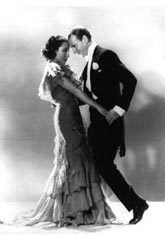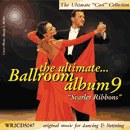Ballroom Dance Etiquette
Contributions from Vivian Beiswenger

Dancing the
Old Fashioned way
These rules are meant to be a summary of some of the more important dance etiquette tips. This is not a complete list, but some of the most common ones.
Remember, a smile is your greatest asset. The more of them that you give away, the more you get. Use a smile to ask for a dance, to accept the invitation, during the dance, and at the end of the dance when you thank your partner. Everyone wants to feel that the person with whom he/she just danced enjoyed it.
1. Plan Ahead: Prepare for a social activity that involves sharing your personal space with others. Shower, use deodorant and mouthwash, minimize the colognes and perfumes, and pack mints. If offered a mint, consider that there may be a reason, and take one or check your breath. If you perspire profusely, consider bringing an extra shirt to change, if needed. The number one reason why people don't want to dance with another person is how he/she smells.
2. Dress to Impress: Wear clothing that does not restrict you or your partner's movement. Clothing and hair styles/adornments should not have moving parts that will hit or snag on your partner or your partner's clothing. Follow the dress code for the event you are attending. It's fun to dress up once in a while. Don't wear jeans and sneakers to a dress-up event.
3. You're Invited: Accept an invitation whenever possible. If you must refuse, it's common, but not required to give a reason (i.e. I'm resting). Do not turn around and accept someone else's offer for that same dance. When possible, offer to do the next or a future dance that you know. It's always acceptable to refuse someone who has hurt you, put your safety at risk, behaved inappropriately in the past, or become a pest by requesting too many dances, but do it graciously.
4. The New Millennium: It's acceptable for women as well as men to request a dance. If the person you are asking is with someone, be respectful and considerate to that person, but do not ask the partner for permission for the dance. This is passé and potentially offensive. Ask the individual directly.
5. Variety is the Spice of Life: Be willing to dance with all levels of partners, including beginners. We were all there once and he/she might remember you after he/she becomes a great dancer. Also, don't monopolize a dancer, especially one who is a better dancer than you. Make it a goal to dance at least one dance with every person.
6. Be Kind: Never criticize your partner's dancing or blame your partner for a misstep. The single biggest secret to success in social dancing, or any kind of partner dancing for that matter, is to make your partner happy. Make your partner feel appreciated and as comfortable as possible. Thank your partner at the end of the dance and walk with him or her off the dance floor unless they are picked up by his or her next partner. Remember the Law of Attraction: what you give, you will get back in spades!
7. Line of Dance: When engaging in a dance that usually travels follow the line of dance. Travel counter-clockwise around the perimeter of the floor. If you are not traveling, stay in the center of the floor. The spot dancers should leave the perimeter of the floor to the traveling dancers. Do not stop and talk on the dance floor for a significant length of time or backup into moving dancers.
8. Accidents Happen: Avoid collisions and protect your partner. If a collision happens, briefly apologize, no matter whose fault it was. Be careful not to push or pull your partner on the dance floor and throw him/her in the direction of other dancers. Ladies, you can help to avoid incidents by warning your partner of traffic behind him, either verbally or by squeezing his hand/arm. And, before you extend your arm in that long stylish reach, check to be sure no one's eye or other body part is in the way.
9. Leave it to the Pros: No matter how good you are or how incapable your partner is in your own mind, do not volunteer dance instruction. Don't count or call out the steps. If you can't lead the pattern acceptably for your partner's ability level, use another figure.
10. Mix it Up: Mixers are often used during social dances to facilitate meeting and dancing with new people. They usually raise the fun quotient at an event. Whether you are the best or worst dancer in the room, if you know the dance, participate. Dancers who don't participate take away from the festivity. Ballroom dancing is a social activity and a mixer is a great way to meet new people and make new friends. You can never have too many friends.
Above all, be happy and have fun! Remember that the Law of Attraction is always at work! "Do what you love. ... As you commit to your joy, you will attract an avalanche of joyful things because you are radiating joy [The Secret]."
Vivian Beiswenger is the Editor of Dance Spotlight and owner of the Ballroom, Latin, & Swing Dance Center in Montgomery County, PA. She is a former Senior VP of USA Dance.

 Online Music Store
Online Music Store 